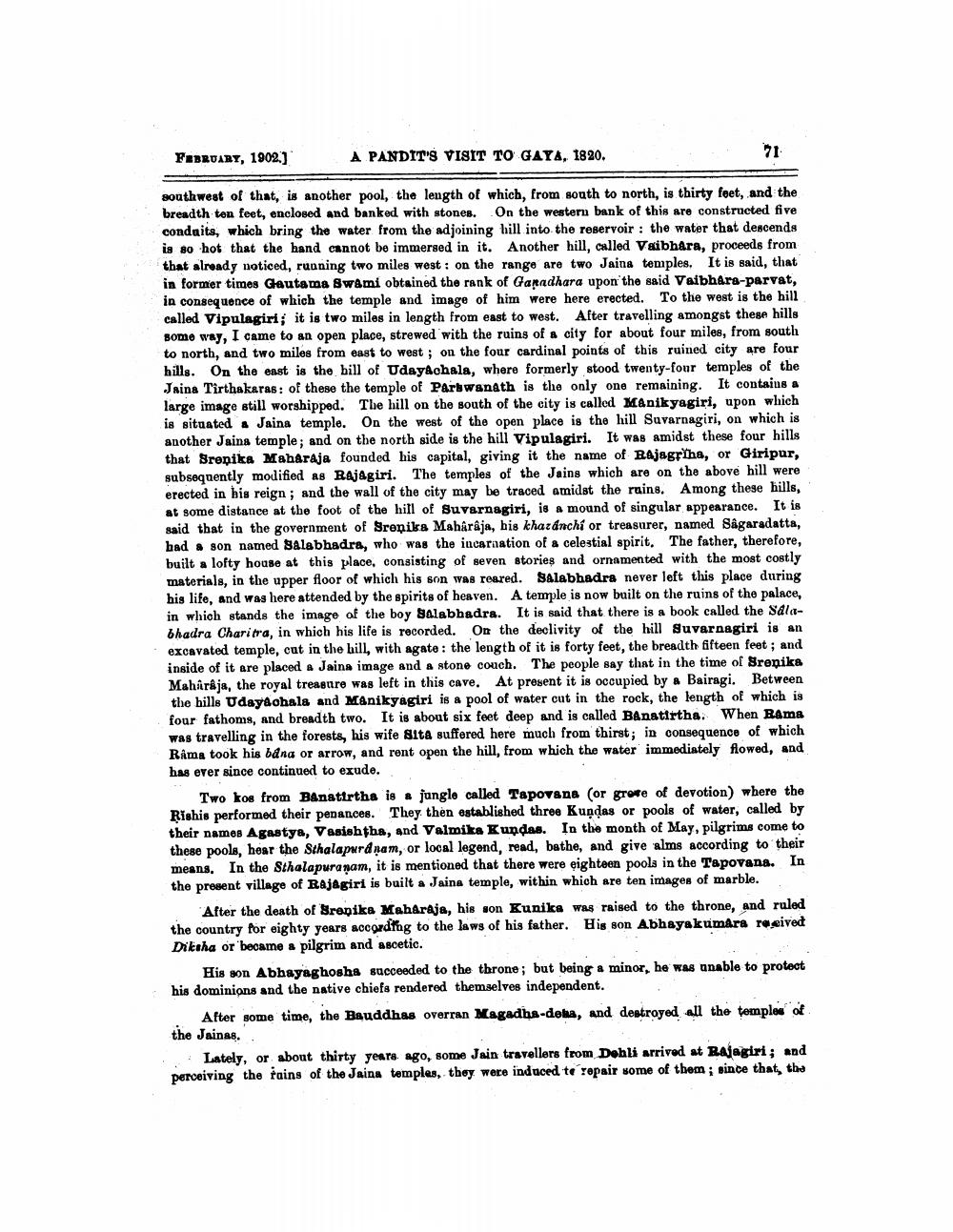________________
FEBRUARY, 1902]
A PANDIT'S VISIT TO GAYA, 1820.
71
southwest of that, is another pool, the length of which, from south to north, is thirty feet, and the breadth ton feet, enclosed and banked with stones. On the western bank of this are constructed five conduits, which bring the water from the adjoining hill into the reservoir : the water that descends is so hot that the hand cannot be immersed in it. Another hill, called Vaibhara, proceeds from that already noticed, running two miles west : on the range are two Jaina temples. It is said, that in former times Gautama Swami obtained the rank of Garadhara upon the said Vaibhara-parvat, in consequence of which the temple and image of him were here erected. To the west is the hill called Vipulagiri; it is two miles in length from east to west. After travelling amongst these hills some way, I came to an open place, strewed with the ruins of a city for about four miles, from south to north, and two miles from east to west ; on the four cardinal points of this ruined city are four hills. On the east is the bill of UdayAchala, where formerly stood twenty-four temples of the Jsina Tirthakaras: of these the temple of Parbwanath is the only one remaining. It contains a large image still worshipped. The hill on the south of the city is called Manikyagiri, upon which is situated a Jaina temple. On the west of the open place is the hill Suvarnagiri, on which is another Jains temple; and on the north side is the hill Vipulagiri. It was amidst these four hills that Sronika Maharaja founded his capital, giving it the name of Rajagriha, or Giripur, subsequently modified as Rajagiri. The temples of the Jains which are on the above hill were erected in his reign; and the wall of the city may be traced amidst the ruins. Among these hills, at some distance at the foot of the hill of Suvarnagiri, is a mound of singular appearance. It is said that in the government of Sreņika Maharaja, his khardnchi or treasurer, named Sågaradatta, had a son named Salabhadra, who was the incarnation of a celestial spirit. The father, therefore, built a lofty house at this place, consisting of seven stories and ornamented with the most costly materials, in the upper floor of which his son was reared. Salabhadra never left this place during his life, and was here attended by the spirits of heaven. A temple is now built on the ruins of the palace, in which stands the image of the boy Salabhadra. It is said that there is a book called the salabhadra Charitra, in which his life is recorded. On the declivity of the hill Suvarnagiri is an excavated temple, cut in the hill, with agate : the length of it is forty feet, the breadth fifteen feet; and inside of it are placed a Jaina image and a stone couch. The people say that in the time of Sreniks Maharaja, the royal treasure was left in this cave. At present it is occupied by a Bairagi. Between the hills Udayaohala and Manikyagiri is a pool of water cut in the rock, the length of which is four fathoms, and breadth two. It is about six feet deep and is called Banatirtha. When Rama was travelling in the forests, his wife Sita suffered here much from thirst; in consequence of which Rama took his bang or arrow, and rent open the hill, from which the water immediately flowed, and has ever since continued to exude.
Two kos from Banatirtha is junglo called Tapovans (or grote of devotion) where the Rishis performed their penances. They then established three Kundas or pools of water, called by their names Agastya, Vasishtha, and Valmika Kundas. In the month of May, pilgrims come to these pools, hear the Sthalapurdņam, or local legend, read, bathe, and give alms according to their means. In the Sthalapuranam, it is mentioned that there were eighteen pools in the Tepovana. In the present village of Rajagiri is built a Jaina temple, within which are ten images of marble.
After the death of Branika Maharaja, his son Kuniks was raised to the throne, and ruled the country for eighty years according to the laws of his father. His son Abhayakumara recived Diksha or became a pilgrim and ascetic.
His son Abhayaghosha succeeded to the throne; but being a minor, he was unable to protect his dominions and the native chiefs rendered themselves independent.
After some time, the Bauddhas overran Magadha-deka, and destroyed all the temples of the Jainas.
Lately, or about thirty years ago, some Jain travellers from Dehli arrived at Bulagiri; and perceiving the tains of the Jaina temples, they were induced to repair some of them ; since that, the




